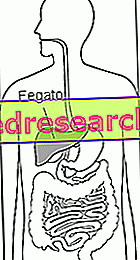Generality
The liver is the largest gland in the human body, located in the upper and right side of the abdomen, just below the diaphragm.

In the hepatic cells the smooth endoplasmic reticulum is particularly developed, a particular cellular organelle used for the synthesis of lipids, to the metabolism of carbohydrates and to the detoxification of metabolic waste and harmful substances. The liver cells are also rich in peroxisomes, cellular organelles that intervene in the neutralization of toxic substances.
The liver weighs about 1000-1500 grams and its size is kept constant with respect to body weight, increasing or decreasing according to it.
The liver plays a major metabolic role, essential for the proper functioning of the entire body. About 6-7% of its weight is glycogen, for an approximate total of 100 grams.
Although the elementary energy substrates absorbed in the intestine (glucose, amino acids, fatty acids) flow into it, its function is not simply digestive. The liver, being a gland, has a secretive action and produces numerous substances such as bile and other metabolic products.
Even without knowing all these anatomical and physiological details, the ancients were aware of the great importance of this organ, so much so that they believed that the courage of a man resided in it (from which derives the expression still in vogue "having liver").
Deepening Articles
Liver Diseases
Liver AngiomaAscetes Liver calculations Liver cirrhosis Cholestasis Cholangitis Hepatic encephalopathyHepatitis A Hepatitis Alcohol Autoimmune Hepatitis B Hepatitis CEpatitis DEpatite And Fulminant Hepatitis Fatty Liver (Steatosis Hepatic) Liver Disease Liver LiverSigns and Symptoms
Light feces Enlarged liver Jaundice Gravid jaundice Neonatal jaundiceMale to the liver Yellow eyes Dark urineClinical tests
Bilirubin Liver biopsy Colalemia Liver tests Liver ultrasound Transaminase Urobilinogen Liver values (blood tests)Diet and Supplements
Nutrition and liver Diet and liver Purifying the liver Liver health Silymarin Herbal tea for purifying the liver Cod liver oilBile
Bile is composed of 82% water, bile acids (12%), lecithin, unesterified cholesterol (0.7%) and other phospholipids (4%).
Bile is essential for the digestion of fat and fat-soluble vitamins (ADEK). After being produced by the liver, it is conveyed to the gall bladder or gallbladder, where it is collected and concentrated to then be poured, at the appropriate time (when the food passes from the stomach to the intestine), in the duodenum.
Liver Diseases
The yellowish coloring of the skin can testify to the presence of an jaundice: a pathological condition due to the retention of bile salts (for example for the migration in the common bile of a gallbladder calculus).
Precisely because of this centrality, when the liver becomes ill, it ends up feeling the whole body. Hepatic activity can be compromised above all by improper lifestyles (smoking habits, alcoholism, drug use, drug abuse and incongruous diet). In particular, as regards nutrition, the main enemies of the liver are alcohol and fats, especially those subjected to high temperatures (fried food, fast food, etc.). Even an inordinate consumption of caffeine and other alkaloids can, in the long run, fatigue our liver unnecessarily.
This important organ can also be affected by very dangerous diseases of viral origin, such as hepatitis, or affected by pathologies that affect other parts of the body. In the case of hepatitis, the infection can occur through contact with infected blood or during unprotected sexual intercourse. Some forms (hepatitis A and E) are also transmitted through contaminated food due to poor hygiene standards.
The liver can go against a particular condition called steatosis or, more commonly, fatty liver. In these cases there is a massive accumulation of triglycerides which, becoming chronic, can give rise to a very serious degenerative process called cirrhosis. Diabetes, a diet high in fat and alcoholism can promote the onset of this disease.
Important liver damage can also be caused by the indiscriminate use of certain drugs, such as some anabolic steroids.
Main functions of the liver
The liver can be called the largest "chemical laboratory" of our body; we can survive without the gallbladder or without the stomach, but if the liver doesn't work properly, the whole body is in big trouble. Many of its functions are essential:
- intervenes in the metabolism of glucides acting as a glycogen deposit that can be used as a source of plasma glucose.
- in addition, the liver directly controls the mobilization of glucose from these deposits based on the body's demands; it therefore has a fundamental role in modulating blood glucose levels.
- It intervenes in the synthesis of fatty acids as a form of depositing excess calories (the synthesis of triglycerides and cholesterol occurs inside the liver).
- The liver destroys and metabolizes the dead red blood cells, recovering the iron bound to hemoglobin and creating metabolites that are added to the bile as pigments.
- It acts as a deposit of vitamins and iron and intervenes in their metabolism.
- Metabolizes ethyl alcohol or ethanol.
- It intervenes in the catabolism of proteins (production of ammonia and urea), deaminating excess amino acids from their digestion. Thanks to this process the carbon skeleton can be used for energy purposes (gluconeogenesis) or deposited as a reserve after being transformed into lipids.
- It converts lactic acid, a waste product synthesized by the muscles during intense physical activity, into glucose.
- The liver also intervenes in the synthesis of non-essential amino acids (transazmination) and of plasma proteins such as albumin and the various coagulation factors (fibrinogen, prothrombin, factors V, VII, IX, X).
- It plays a leading role in the detoxification of metabolic waste or toxins introduced into the body through nutrition, pollution or drugs (makes these compounds water-soluble, facilitating excretory activity from the kidney).
- The liver intervenes in the maintenance of the normal hydrosaline balance
- In the liver the synthesis of a hormone occurs, called somatomedin or IGF-1, under the stimulus of somatotropin or GH. These hormones have a synergistic action that, especially in puberty, promotes bone and muscle growth (powerful anabolic action). The liver also produces protein substances necessary for the transport of hormones in the blood stream.



